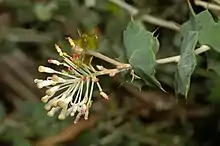Grevillea amplexans
Grevillea amplexans is a species of flowering plant in the family Proteaceae and is endemic to the Mid West region of Western Australia. It is a spreading shrub with arching branches, stem-clasping, sharply-pointed, lobed or toothed leaves and white to cream-coloured flowers.
| Grevillea amplexans | |
|---|---|
 | |
| Scientific classification | |
| Kingdom: | Plantae |
| Clade: | Tracheophytes |
| Clade: | Angiosperms |
| Clade: | Eudicots |
| Order: | Proteales |
| Family: | Proteaceae |
| Genus: | Grevillea |
| Species: | G. amplexans |
| Binomial name | |
| Grevillea amplexans | |
Description
Grevillea amplexans is a spreading shrub that typically grows to a height of 1–3 m (3 ft 3 in – 9 ft 10 in) and has arching branches. Its leaves are 7–26 mm (0.28–1.02 in) long, 10–35 mm (0.39–1.38 in) wide and star-shaped or egg-shaped with three to seven lobes or five to eleven teeth on the edges, and a stem-clasping base. The flowers are arranged in more or less spherical to domed groups on the ends of branches. The flowers are white to cream-coloured and glabrous, the pistil 2.5–5.8 mm (0.098–0.228 in) long with a white style. Flowering occurs from July to December and the fruit is an oblong follicle 9–12 mm (0.35–0.47 in) long.[2][3]
Taxonomy
Grevillea amplexans was first formally described in 1870 by George Bentham from an unpublished description by Ferdinand von Mueller in Flora Australiensis.[4] The specific epithet (amplexans) means "encircling" or "embracing", referring to the base of the leaves.[5]
In 2000, Makinson and Wilson described three subspecies in the Flora of Australia, and the names are accepted by the Australian Plant Census:
- Grevillea amplexans subsp. adpressa (Olde & Marriott) Makinson[6] tends to have smaller leaves than subsp. amplexans and often has down-curved leaf edges;[7][8]
- Grevillea amplexans F.Muell. ex Benth. subsp. amplexans;[9][10][11]
- Grevillea amplexans subsp. semivestita Makinson[12] is distinguished from the autonym by its silky-hairy branchlets and glabrous, sometimes glaucous lower leaf surfaces.[13][14]
(Grevillea amplexans subsp. adpressa was first formally described in 1993 by Olde and Marriott who gave it the name Grevillea adpressa in the journal Nuytsia.)[15][16]
Distribution and habitat
This grevillea grows in sand on sandplains between Geraldton, Coomberdale and Moora in the Avon Wheatbelt, Geraldton Sandplains and Swan Coastal Plain biogeographic regions of Western Australia.[3] Subspecies adpressa grows in low heath between Mingenew and Watheroo,[7][8] and subsp. amplexans grows in heathland or mallee-shrubland[10][11] and subsp. semivestita occurs in shrubland and heath from Watheroo National Park to near Carnamah.[13][14]
Conservation status
Subspecies amplexans is classified as "not threatened" by the Government of Western Australia Department of Biodiversity, Conservation and Attractions,[11] but subsp. adpressa is listed as "Priority One" meaning that it is known from only one or a few locations which are potentially at risk,[17] and subsp. semivestita as "Priority Two"[14] meaning that it is poorly known and from only one or a few locations.[17]
References
- "Grevillea amplexans". Australian Plant Census. Retrieved 21 November 2021.
- "Grevillea amplexans". Australian Biological Resources Study, Department of Agriculture, Water and the Environment: Canberra. Retrieved 21 November 2021.
- "Grevillea amplexans". FloraBase. Western Australian Government Department of Biodiversity, Conservation and Attractions.
- "Grevillea amplexans". APNI. Retrieved 21 November 2020.
- Sharr, Francis Aubi; George, Alex (2019). Western Australian Plant Names and Their Meanings (3rd ed.). Kardinya, WA: Four Gables Press. p. 131. ISBN 9780958034180.
- "Grevillea amplexans subsp. adpressa". Australian Plant Census. Retrieved 21 November 2021.
- "Grevillea amplexans subsp. adpressa". Australian Biological Resources Study, Department of Agriculture, Water and the Environment: Canberra. Retrieved 21 November 2021.
- "Grevillea amplexans subsp. adpressa". FloraBase. Western Australian Government Department of Biodiversity, Conservation and Attractions.
- "Grevillea amplexans subsp. amplexans". Australian Plant Census. Retrieved 21 November 2021.
- "Grevillea amplexans subsp. amplexans". Australian Biological Resources Study, Department of Agriculture, Water and the Environment: Canberra. Retrieved 21 November 2021.
- "Grevillea amplexans subsp. amplexans". FloraBase. Western Australian Government Department of Biodiversity, Conservation and Attractions.
- "Grevillea amplexans subsp. semivestita". Australian Plant Census. Retrieved 21 November 2021.
- "Grevillea amplexans subsp. semivestita". Australian Biological Resources Study, Department of Agriculture, Water and the Environment: Canberra. Retrieved 21 November 2021.
- "Grevillea amplexans subsp. semivestita". FloraBase. Western Australian Government Department of Biodiversity, Conservation and Attractions.
- "Grevillea adpressa". APNI. Retrieved 21 November 2020.
- Olde, Peter M.; Marriott, Neil R. (1993). "New species and taxonomic changes in Grevillea (Proteaceae: Grevilleoideae) from south-west Western Australia". Nuytsia. 9 (2): 250–252. Retrieved 20 November 2021.
- "Conservation codes for Western Australian Flora and Fauna" (PDF). Government of Western Australia Department of Parks and Wildlife. Retrieved 16 December 2015.